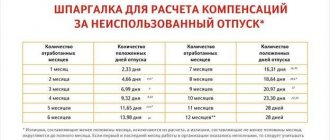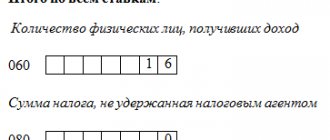Billing period
The duration of the calculation period when calculating vacation pay in 2015 depends on how long the employee works for the employer. The billing period cannot be more than a year.
Option 1
The employee worked for more than a year before the leave.
The billing period will be 12 calendar months prior to the month in which he goes on vacation. A calendar month is taken from the 1st to the last day inclusive. That is, in May from 1 to 31, and in February - up to the 28th inclusive. Option 2
The employee worked for less than a year before the leave.
The billing period will be the entire time during which he is registered in the organization.
Earnings for the billing period
When calculating your earnings, include all payments that are provided for by the organization’s remuneration system. This:
- salary accrued for time worked;
- allowances and additional payments (for class, length of service, combination of professions, etc.);
- compensation payments related to working hours and working conditions - regional coefficients and percentage increases in wages, additional payments for work in hazardous and difficult working conditions, at night, in multi-shift work, on weekends and holidays and overtime;
- other bonuses and rewards.
General rules for calculating “labor” average earnings
The procedure for determining average earnings in all cases determined by the Labor Code of the Russian Federation is established by Decree of the Government of the Russian Federation dated December 24, 2007 No. 922.
The basic rules here are as follows:
- Average earnings are calculated for the last 12 months
- All payments related to work activity are taken into account: salary (tariff), allowances, bonuses, etc.
- Payments for unworked periods (vacation pay, sick leave, etc.) are not included in the calculation.
- If an employee works full time or fulfills production standards, his average earnings cannot be lower than those calculated on the basis of the minimum wage.
The inclusion of bonus payments in average earnings is associated with a number of features (clause 15 of Resolution No. 922):
- Monthly bonuses are generally included in the same way as salaries. But if they are accrued on different bases, then no more than one bonus per month is taken for each indicator.
- Quarterly and semi-annual bonuses, if the accrual period is fully included in the calculation period, are taken in full. If the bonus period and the billing year “overlap” partially, then part of the bonus is used for calculation, which corresponds to the number of “coinciding” months.
- Annual bonuses, long service awards, etc. are taken into account in full if they relate to the year preceding the “average” payment.
A situation may arise where in the previous 12 months the employee did not have income on which to base the calculation. Then use the following options (clauses 6-8 of resolution No. 922):
- Income is taken for the 12 months preceding the billing period.
- If there was no income before the beginning of the current month, then data for this month is used.
- If the salary has not yet been accrued at all, then the calculation is made on the basis of the tariff (salary).
If the organization has experienced an increase in wages, and the billing period “covers” a time with a lower wage level, then it may turn out that payments based on average earnings will be lower than for other employees. To avoid such a situation, the calculated amount must be increased by a factor equal to the ratio of the “new” and “old” salary (clause 16 of Resolution No. 922).
Average daily earnings
Once the employee’s earnings for the pay period have been determined, you need to calculate the average daily earnings. The procedure for determining average daily earnings depends on whether the employee has worked the entire pay period and whether he is given leave in calendar or working days. If the billing period is fully
and vacation is provided in calendar days, the average daily earnings are determined by formula 1:
| daily earnings | Earnings accrued for the billing period | 29, 3 days (average monthly number of calendar days) |
The indicator “29.3 is used exclusively for the purpose of determining average earnings for the payment of vacation pay and compensation for unused vacation.
The procedure for calculating “labor” average earnings
The method for calculating average earnings depends on the purpose for which the size of the payment is determined
- Vacation pay calculation
In this case, the average daily earnings (ADE) are determined based on the “conditional” number of calendar days in a month – 29.3.
In the simplest situation, when all 12 months of the billing period are worked out without gaps:
SDZ = FOT / (12 x 29.3)
Payroll - all payments included in the calculation.
But, of course, this is not always the case. An employee could work for less than a year, take sick leave, etc. Then the formula takes the following form
SDZ = payroll (KPM x 29.3 + DNP)
KPM - number of months worked in full
DNP - calendar days falling on time worked in “incomplete” months
DNP = 29.3 / KD x KDR
CD – the total number of calendar days in an “incomplete” month
KDR - the number of calendar days falling on the worked period
- Calculation of average earnings in other cases provided for by the Labor Code of the Russian Federation
If the calculation of average earnings is not related to vacation pay (for example, an employee goes on a business trip), then the formula will be simpler:
SZ = FOT / KD (CC)
KD (KCH) is the number of days (or hours - with hourly accounting) actually worked during the reporting period.
Next, you need to multiply the average earnings by the number of days to be paid. For vacations these will be calendar days, in other cases - working days.
B = SDZ x D
Vacation pay calculation
After calculating the average daily earnings, you can calculate the amount of vacation pay that must be paid to the employee. If vacation is provided in calendar days, then vacation pay in 2015 will be calculated according to formula 2:
| Average daily earnings | Number of calendar days of vacation |
Example 1
From May 25 to June 21, 2015, Petrov was granted basic paid leave. Duration of vacation is 28 calendar days. The billing period - from May 1, 2014 to April 30, 2015 - has been fully worked out. During the billing period, the employee was accrued 360,000 rubles. (RUB 30,000 x 12 months) This amount is fully included in the calculation of vacation pay in 2015. The average daily salary of an employee is: 360,000 rubles. : 12 months : 29, 3 days = 1023.89 rub. The total amount of vacation pay was: 1023.89 rubles. x 28 days = 28,668.92 rub.
Example 2
From June 15 to June 28, 2015, Sidorov was granted basic paid leave of 14 calendar days. The billing period - from June 1, 2014 to May 31, 2015 (12 months) - has been fully worked out. During the billing period, the employee was accrued 240,000 rubles. (RUB 20,000 x 12). This amount is fully included in the calculation of vacation pay. The average daily earnings used to calculate vacation pay in 2015 will be: 240,000 rubles. : 12 months : 29, 3 days . = 682.59 rub. The total amount of vacation pay will be: 682.59 rubles. x 14 days = 9,556.26 rub.
| Dear visitors! The site offers standard solutions to problems, but each case is individual and has its own nuances. |
| If you want to find out how to solve your particular problem, call toll-free ext. 504 (consultation free) |
Calculation of vacation pay if the month is not fully worked
An employee has not worked the entire month if:
- received an average salary (was on secondment...);
- was ill or received maternity benefits;
- was on leave without pay, etc.
| Average daily earnings of the billing period not fully worked | Number of calendar days of vacation |
| Average daily earnings of the billing period not fully worked | = |
| Earnings accrued for the billing period | |
| Number of calendar days in incomplete calendar months |
If the employee has not worked the entire month
, then the number of days in this month must be recalculated using formula 3:
| Number of calendar days in an incomplete month worked | 29, 3 days | Number of calendar days in this month (28, 29, 30 or 31 days) | Number of days worked in this partial month |
Example 3
Employee Mishina’s vacation is 14 days from 04/06/2015 to 04/19/2015. The billing period is the period from 04/01/2014 to 03/31/2015. Mishina’s monthly salary is 30,000 rubles. From 03/02/2015 to 03/17/2015 (16 days) Mishina was on sick leave. In the billing period, Mishina worked 11 full months and 15 calendar days in an incomplete month (March 2015). (15 days = 31 days - 16 days of sick leave). Salary in March 2015 amounted to 10,000 rubles. In total, 340,000 rubles were accrued in the billing period. (30,000 rubles x 11 months + 10,000 rubles) Now we determine the number of calendar days in an incomplete month (March 2015): We use the above formula 3: 29, 3: 31 days. x 15 days = 14, 25 days. The total amount of vacation pay was: 340,000 rubles. : (29.3 x 11 months + 14.25 days) x 14 days vacation = 14,143.50 rub.
The procedure for calculating vacation pay was changed in 2021, in particular, the coefficient used to calculate vacation compensation for employees of enterprises changed. The change in the coefficient is due to the increase in the number of holidays in the country. The coefficient for calculating vacation pay in 2021 now has a different value, which we will discuss in this article.
We will also explain in detail how vacation pay is calculated.
Basics
So, let's use our mathematical apparatus to obtain the basic formula. A normal month has 30 or 31 days, so we can use 1 or 0 to get alternately, and then simply add a constant to this number: We get a table, with the correct values in bold:
| x | 1 | 2 | 3 | 4 | 5 | 6 | 7 | 8 | 9 | 10 | 11 | 12 |
| f(x) | 31 | 30 | 31 | 30 | 31 | 30 | 31 | 30 | 31 | 30 | 31 | 30 |
Not a bad start! There are already correct values for January and for the months from March to July inclusive. February is a special case, and we will deal with it a little later. After July, for the remaining months, the order of receiving 0 and 1 should be reversed. To do this, we can add 1 to the dividend:
| x | 1 | 2 | 3 | 4 | 5 | 6 | 7 | 8 | 9 | 10 | 11 | 12 |
| f(x) | 30 | 31 | 30 | 31 | 30 | 31 | 30 | 31 | 30 | 31 | 30 | 31 |
The values for August through December are now correct, but as expected, the values for the other months are incorrect. Let's see how we can combine these formulas.
Calculation period for vacation
The new calculation procedure does not change the formula, but changes some of its components:
- The coefficient of the average number of days worked by an employee becomes equal to 29.3.
- The average salary of a specialist is taken into account.
- The calculation period is taken into account. It is based on the amount of money earned in one day.
- The time worked in the company is also taken into account. When an employee goes on vacation after six months rather than after 12 months, vacation pay is calculated based on the shorter period.
What data is used to calculate vacation pay?
When calculating monetary remuneration for employees going on vacation, the following data is used:
- accrued allowances;
- required bonuses;
- surcharges at certain rates;
- the total number of positions held by the official and the salaries for them;
- additional payments for qualifications or class;
- increase for length of service;
- allowances for work in difficult conditions, for example, northern payments.
Paid allowances and bonuses must be approved by the director of the enterprise.
The accountant indicates the amount of all possible additional payments and the amount of vacation pay without them; the manager chooses which one to approve.
The following payments cannot affect the amount of vacation pay:
- funds allocated for business trip expenses;
- material aid;
- "sickness" payments;
- funds for transportation costs;
- compensation for food;
- payment for loss of ability to work.
Vacation pay calculation coefficient used from 2021 and formulas using it
The average number of days in a month, established last year for the convenience of calculating vacation pay, is called a coefficient. Its value from 2021 is 29.3. It is used to calculate the average daily earnings, and then the funds due to the vacationer. Let's talk about several options for calculating vacation pay in 2017, taking into account the different amounts of time worked by employees:
- Full year. SDZ (average daily earnings) = payments included in the calculation of SDZ / 12 / 29.3
- Incomplete year or month. We calculate the days fully worked in each month (to do this, we multiply the number of months worked in a year by 29.3). Next, it takes into account the number of days worked in an incomplete month (29, 3 divided by the number of days in the month and multiplied with the previous indicator). We add the two obtained indicators and get the number of days used in the calculation. SDZ = total income / number of days received.
- Vacation unused by the employee. Each employee has the right to monetary compensation for vacation that he did not take. For such a calculation, the principle specified in paragraph 2 is applied, but taking into account one nuance. SDZ is multiplied by the total number of days of the employee's rest period. (see picture 1). By selecting the desired number from the table and substituting it into the formula, we obtain the required payment amount.
- Full vacation including bonus payments. Bonus + earnings for the year / 12 / 29, 3 x 28 (number of vacation days).
How to calculate average salary
The general procedure by which it is necessary to calculate the average monthly salary is established by the Labor Code of the Russian Federation (Labor Code of the Russian Federation, Article 139) and a special annex that has been in force since 2007 after approval by the Government of the Russian Federation. The average salary in 2021 is calculated according to these regulations. Due to the fact that questions and difficulties often arise when calculating the average salary, amendments have been made to the regulation more than once.
Based on the position rules, the following data is used in the calculation:
- actual accrued wages for the working year (the last 12 months, or a fewer number of months, depending on when the employee was hired);
- actual time worked for all calendar months.
Ideally, if an employee worked without sick leave, personal leave, etc., the formula for calculating average income is as follows:
PWP=Payments for 12 months/12
To calculate vacation pay in accounting practice, average daily income is used. That is, the result of the calculation using the first formula (average monthly salary) must be divided by the average statistical indicator of the number of days in a month, which, for example, in 2021 was equal to 29.3 days.
ADD=SWP/Average number of days in a month
Scheme for calculating average wages
There is a fairly simple algorithm that allows you to calculate the average monthly income of an employee:
- We add up all payments transferred to the employee’s account for a specific period, including: salary with all allowances and coefficients. If an employee receives part of his earnings monthly in the form of goods and services, then their cost is also taken into account; variable payments (bonuses, motivational rewards, etc.); other payments provided for by the labor code, contract or other provisions.
- We calculate the billing period - this is the number of days according to the calendar. It does not include days when the employee has already been accrued income, which was calculated according to the average: sick leave, absence from work with continued pay.
- The amount calculated in the first point is divided by the duration of the period (the result of the second point).
Average number of calendar days in a month
However, such a number of workdays is valid if the workweek is five days. Is a longer duration possible? Actually yes.
The legislation allows employers to extend the usual working week by one more day. It turns out that only Sunday remains a day off. In this case, one day per week should be subtracted from calendar days.
However, the number of hours should still not exceed a forty-hour work week. In Soviet times, until 1992, vacation was calculated based on a six-day working week, and to pay for it, they used the average monthly number of working days per year with a six-day week - 25.4. That is, all holidays and Sundays were subtracted from 365 days, and then divided by 12. To prevent the calculation of vacation from being distorted in leap years, the average value was taken over several years, while the number of holidays remained unchanged, as well as the number of Sundays. First, we calculate the number of calendar days in this month, for which we divide 29.3 by the number of days in the month and multiply by the number of days considered worked.
Then we calculate the average earnings per day. To do this, 29.3 must be multiplied by the number of months that do not have exclusion periods and added with the number of calendar days in the month that is not fully worked. After that, the employee’s earnings (full, for the entire calculation period) are divided by the result obtained. Employees with summarized working hours . The new Regulations take into account the decision of the Supreme Court of the Russian Federation dated July 13, 2006 No. GKPI06-637, which found it contrary to Art.
139 Labor Code of the Russian Federation, paragraph. 4 clause 13 of the Regulations on average wages, approved by Resolution No. 213, which states that for employees with cumulative working hours, the average earnings for vacation pay should be calculated not on the basis of average daily earnings, but on the basis of average hourly earnings.
February
Any month has 30 or 31 days, except February with its 28 (leap years are beyond the scope of this task). Currently, according to our formula, it has 30 days, so it would be nice to subtract the expression equal to 2 at . The best I could come up with is this, which applies the mask to all months after February:
| x | 1 | 2 | 3 | 4 | 5 | 6 | 7 | 8 | 9 | 10 | 11 | 12 |
| 2 mod x | 0 | 0 | 2 | 2 | 2 | 2 | 2 | 2 | 2 | 2 | 2 | 2 |
Changing the base constant to 28 and adding 2 to the remaining months, we get the formula:
| x | 1 | 2 | 3 | 4 | 5 | 6 | 7 | 8 | 9 | 10 | 11 | 12 |
| f(x) | 29 | 28 | 31 | 30 | 31 | 30 | 31 | 31 | 30 | 31 | 30 | 31 |
Unfortunately, January is now 2 days shorter. But, fortunately, it is very easy to get an expression that will only apply to the first month: it is the inverse of the number rounded down. Multiplying it by 2 we get the final formula:
| x | 1 | 2 | 3 | 4 | 5 | 6 | 7 | 8 | 9 | 10 | 11 | 12 |
| f(x) | 31 | 28 | 31 | 30 | 31 | 30 | 31 | 31 | 30 | 31 | 30 | 31 |
Calendar days of the billing period
Employee Mishina’s vacation is 14 days from 04/06/2015 to 04/19/2015. The billing period is the period from 04/01/2014 to 03/31/2015. Mishina’s monthly salary is 30,000 rubles. From 03/02/2015 to 03/17/2015 (16 days) Mishina was on sick leave. In the billing period, Mishina worked 11 full months and 15 calendar days in an incomplete month (March 2015). (15 days = 31 days - 16 days of sick leave). Salary in March 2015 amounted to 10,000 rubles. In total, 340,000 rubles were accrued in the billing period. (30,000 rubles x 11 months + 10,000 rubles) Now we determine the number of calendar days in an incomplete month (March 2015): We use the above formula 3: 29, 3: 31 days. x 15 days = 14, 25 days. The total amount of vacation pay was: 340,000 rubles. : (29.3 x 11 months + 14.25 days) x 14 days vacation = 14,143.50 rub. From May 25 to June 21, 2015, Petrov was granted basic paid leave. Duration of vacation is 28 calendar days. The billing period - from May 1, 2014 to April 30, 2015 - has been fully worked out. During the billing period, the employee was accrued 360,000 rubles. (RUB 30,000 x 12 months) This amount is fully included in the calculation of vacation pay in 2015. The average daily salary of an employee is: 360,000 rubles. : 12 months : 29, 3 days = 1023.89 rub. The total amount of vacation pay was: 1023.89 rubles. x 28 days = 28,668.92 rub.
- salary accrued for time worked;
- allowances and additional payments (for class, length of service, combination of professions, etc.);
- compensation payments related to working hours and working conditions - regional coefficients and percentage increases in wages, additional payments for work in hazardous and difficult working conditions, at night, in multi-shift work, on weekends and holidays and overtime;
- other bonuses and rewards.
- The coefficient of the average number of days worked by an employee becomes equal to 29.3.
- The average salary of a specialist is taken into account.
- The calculation period is taken into account. It is based on the amount of money earned in one day.
- The time worked in the company is also taken into account. When an employee goes on vacation after six months rather than after 12 months, vacation pay is calculated based on the shorter period.
Vacation pay calculation
- Received payment in the form of average earnings (with the exception of breaks for feeding the child in accordance with the law). For example, the time of a business trip or other paid leave;
- Was on sick leave or maternity leave;
- Didn’t work due to downtime through no fault of his own;
- Did not participate in the strike, but due to it could not work;
- Used additional paid days off to care for disabled children and people with disabilities since childhood;
- In other cases, he was released from work with full or partial retention of wages or without pay. For example, vacation time at your own expense or parental leave.
- All payments accrued to the employee for the time excluded from the payroll period. They are listed in clause 5 of the Regulations. For example, average earnings for days of business trips and in other similar cases, social benefits, payments for downtime;
- All social benefits and other payments not related to wages. For example, financial assistance, payment of the cost of food, travel, training, utilities, recreation, gifts for children (clause 3 of the Regulations);
- Bonuses and remunerations not provided for by the remuneration system (clause “n. 2 of the Regulations”).
Important ! Non-working days to which holiday weekends are postponed are included in the calculation. If the day off coincides with a holiday, then the Government of the Russian Federation issues a resolution setting the date to which the day off and holiday is transferred.
For example, in 2021, February 23 fell on a Saturday, and the day off from that day was moved to May 10. If an employee is on vacation on May 10, this day must also be paid.
- During the billing period, immediately before or during vacation;
- The increase occurred in relation to payments not of one or several employees, but in relation to the entire organization, its branch or at least a structural unit (clause 16 of the Regulations, approved by Decree of the Government of the Russian Federation of December 24, 2007 No. 922). For example, if the salaries of all employees of the “Accounting of the enterprise” department were increased, then it is necessary to apply the coefficients when calculating vacation pay for all accountants of the enterprise. If salaries were increased only for salary accountants, the coefficient does not apply.
From May 25 to June 21, 2015, Petrov was granted basic paid leave. Duration of vacation is 28 calendar days. The billing period - from May 1, 2014 to April 30, 2015 - has been fully worked out. During the billing period, the employee was accrued 360,000 rubles. (RUB 30,000 x 12 months) This amount is fully included in the calculation of vacation pay in 2015. The average daily salary of an employee is: 360,000 rubles. : 12 months : 29, 3 days = 1023.89 rub. The total amount of vacation pay was: 1023.89 rubles. x 28 days = 28,668.92 rub. For what period are vacation pay accrued? The determining factor for this is the length of time the employee has worked for a given employer before going on leave. . The calculation period for calculating vacation pay directly depends on whether the employee has worked for the employer for a full year or not. If you have worked with the employer for more than a year before going on vacation, the period for calculating vacation pay includes 12 calendar months before the month the employee goes on vacation.
The period for calculating vacation pay is calculated according to the actual length of the month - from the 1st to the last day of the month inclusive (for example, in August on the 31st, in February on the 28th or 29th, etc.) The labor legislation of the Russian Federation determines the minimum duration of labor leave in the amount of 28 calendar days. In addition to the minimum labor leave, legislation may grant an employee the right to additional leaves, due to which the total duration of labor leave is increased. Calculation of the number of vacation days in this case will include additional days of vacation for work in harmful (dangerous) working conditions, in conditions of irregular working hours, etc. Certain categories of workers also have the right to extended vacation: military personnel, medical workers, miners, etc. The coefficient shows the average number of days in a month excluding holidays. Until April 2, the number 29.4 was written in Article 139 of the Labor Code of the Russian Federation.
Meanwhile, the number of holidays increased from 12 to 14 days back in 2012, when January 6 and 8 were added. Hence it turns out: (365 days - 14 days) / 12 months. = 29.25. Officials rounded this figure to 29.3. The previous figure 29.4 is still stated in paragraph 10 of the Regulations approved by Decree of the Government of the Russian Federation of December 24, 2007 No. 922. This norm should also be changed in the near future.
Until this is done, you still need to focus on the new coefficient. Average Number of Calendar Days in a Month
Read on the Russia-Ukraine website:
- Average Consumption of Water and Electricity in the Apartment
- Statute of Limitations for Loans from Bailiffs
- Storage periods for Time Sheets
- Standard Tax Deductions for a Disabled Child from Childhood 3 Groups
- Standard Child Tax Deduction for Alimony
Attention!
Due to recent changes in legislation, the legal information in this article may be out of date! Our lawyer can advise you free of charge - write your question in the form below.
Enter the site
RSS Print
Category : Labor legislation Replies : 27
You can add a topic to your favorites list and subscribe to email notifications.
« First ← Prev.1 Next → Last (3) »
| Muna |
| I’m asking a very stupid question, but maybe someone can explain to me where the average monthly number of calendar days for the year, 29.7, comes from. . By doing the math I get 30.4. Why do you need to use 29.7 when calculating vacation??? |
| I want to draw the moderator's attention to this message because: Notification is being sent... |
| working work at work |
| Li-Lu [email hidden] Belarus, Minsk Wrote 3162 messages Write a private message Reputation: 460 | #2[84161] May 25, 2009, 9:07 |
Notification is being sent...
| Muna [email hidden] Belarus, Minsk Wrote 804 messages Write a private message Reputation: | #3[84162] May 25, 2009, 9:08 |
days? I want to draw the moderator's attention to this message because:
Notification is being sent...
working work at work| Ciardi [email hidden] Belarus Wrote 23689 messages Write a private message Reputation: 3490 | #4[84165] May 25, 2009, 9:12 |
Phil wrote:
Chiardi wrote:
Lesha! Please tell me how then, from a mathematical point of view, the figure 29.7 is obtained - the average monthly number of calendar days per year?
If Alexey doesn’t mind, I’ll answer. 29.7 is the average number of days when calculating vacation pay. 1. 5 * 365 = 1825 days. 2. During these 5 years, 1 leap year is 1825 + 1 = 1826. 3. Each year has 9 (nine) holidays (January 1, January 7, March 8, Radunitsa, May 1, May 9, July 3, November 7 , December 25). As everyone remembers, when calculating vacation pay, holidays are not taken into account. 4. For 5 years there are 45 holidays (9 * 5). 5. The average monthly number of calendar years on average over 5 years is 29.7 ((1826 - 45) / (5 * 12)).
I want to draw the moderator's attention to this message because:Notification is being sent...
| Muna [email hidden] Belarus, Minsk Wrote 804 messages Write a private message Reputation: | #5[84169] May 25, 2009, 9:17 am |
Notification is being sent...
working work at work| Ciardi [email hidden] Belarus Wrote 23689 messages Write a private message Reputation: 3490 | #6[84173] May 25, 2009, 9:19 |
calendar days. This is where sometimes we get such an incident as the existence of 13 months a year (see the topic “Personnel Department No. 10”) I want to draw the moderator’s attention to this message because:
Notification is being sent...
| Muna [email hidden] Belarus, Minsk Wrote 804 messages Write a private message Reputation: | #7[84183] May 25, 2009, 9:36 am |
Notification is being sent...
working work at work| Muna [email hidden] Belarus, Minsk Wrote 804 messages Write a private message Reputation: | #8[84194] May 25, 2009, 10:12 |
Notification is being sent...
working work at work| Allegra" [email hidden] , Wrote 26284 messages Write a private message Reputation: 3478 | #9[84198] May 25, 2009, 10:19 |
Notification is being sent...
I do not give advice in private messages. Please ask all questions on the forum.| Muna [email hidden] Belarus, Minsk Wrote 804 messages Write a private message Reputation: | #10[84205] May 25, 2009, 10:33 |
Notification is being sent...
working work at work« First ← Prev.1 Next → Last (3) »
In order to reply to this topic, you must log in or register.










